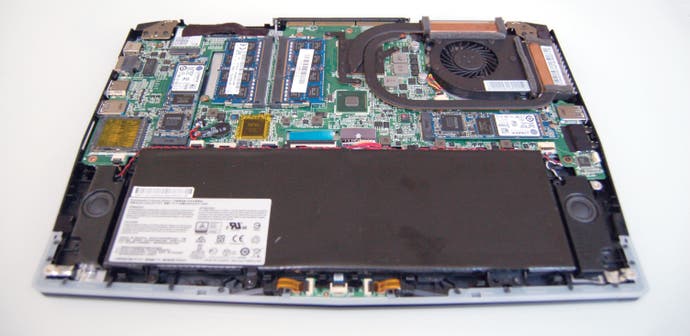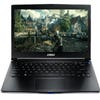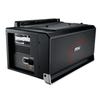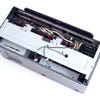MSI GS30 Shadow with Gaming Dock review
Meet the 13-inch Intel quad-core ultrabook that transforms into a desktop gaming powerhouse.
Imagine a laptop with the footprint and weight of the MacBook Air, packing a full quad-core Intel Core i7 processor, Iris Pro 5200 graphics, RAID-0 SSDs and a 1080p 13.3-inch PLS display. For many - us included - it sounds like a dream come true: a truly portable form factor combined with processing power that's a substantial leap beyond the standard ultrabook. Now imagine that when you get home, you can place the unit into a bespoke dock that comes complete with Nvidia's GTX 980 graphics card, turning a humble notebook into a thoroughbred gaming powerhouse. It all sounds too good to be true, but that's exactly what MSI's fascinating GS30 Ghost offers.
It seems that MSI is on a mission to integrate a first class PC gaming experience with a mobile form factor. We've already seen the brilliantly insane GT80 Titan SLI - a monstrous 18.4-inch laptop with enough gaming power to take on a Titan X-based desktop PC. This approach is somewhat different, essentially allowing you to decouple the laptop from the high-end GPU, whereupon it becomes a more traditional ultrabook-style offering - albeit with class-leading processing power in a 13.3-inch form factor. The question is whether this curious arrangement actually works.
There's clearly much to commend about the laptop itself. Initial impressions suggest a slightly thicker MacBook Air, and weight-wise they're pretty much like-for-like. Build quality is decent, if not spectacular - a mixture of black metal and plastic, with the usual chiclet-style keyboard. The 1080p screen is bright and vibrant with decent viewing angles (though Windows 8.1's DPI scaling still looks pretty poor, resulting in ugly-looking fontography), while the trackpad is above average, responsive enough to the lightest touch. Audio is a little disappointing though, with little bass and speakers mounted on the bottom of the laptop, meaning that sound reproduction is permanently muffled. Ports selection is decent though: we have an SD card slot, two USB 3.0 ports, an HDMI port and gigabit LAN.
The GS30 uses an Intel Core i7 4870HQ processor - a full Haswell quad-core chip that is architecturally identical to a desktop processor, just running at lower clocks. This is a part with a 47W TDP, as opposed to the 15W dual-core parts found in ultrabooks. This offers up a gargantuan leap in processor power, but it comes at a cost. Dissipating the heat generated by a 47W processor requires a meaty cooling assembly - something that can't really be housed in a thin and light 13.3-inch chassis. The end result is increased heat over an ultrabook, but more annoyingly - loud, high-pitched fans, which seem to kick in even on fairly basic tasks, like installing a Steam game, for instance.
- Order the MSI GS30 Shadow from Amazon with free shipping
When the processor's under load, the noise can be quite overwhelming - it's not so much the loudness, but the pitch that is the issue. But the question is whether MSI can effectively cool a monster processor like this in such a small chassis. We used Intel's extreme tuning tool for stress-testing, finding that the processor did momentarily hit the max 3.7GHz turbo before rapidly hitting thermal limits, throttling down to its rated 2.8GHz within the minute. And there it stayed - albeit at recorded temperatures of 90 degrees Celsius.
In short, the GS30 Shadow succeeds in accommodating a full Core i7 chip in an ultra-mobile laptop form factor - if you don't mind a somewhat loud laptop. Unfortunately the knock-on effect of this could be a deal-breaker for many: the four-cell battery barely manages 2.5 hours of life on fairly simple tasks. It seems that even in a mostly idle state, the i7 still draws much more power than an ultrabook processor.
However, it is good to see that MSI hasn't skimped on the components. This particular i7 comes with Iris Pro 5200 graphics, the state-of-the-art for the Haswell architecture, combining the best integrated GPU solution Intel has with 128MB of attached eDRAM - the idea being that this ultra-fast RAM makes up for the slow DDR3 system memory. Even without the Gaming Dock, could the GS30 Shadow hand in creditable gaming performance on the go?
We'll reel off our Iris Pro experiences quickly - Crysis 3 runs well at 720p on low settings with medium quality textures and FXAA, handing in performance levels mostly north of 30fps. Tomb Raider was a bit of a revelation, capable of 1080p30 gameplay on its normal preset, while Metal Gear Solid 5: Ground Zeroes is playable at 720p on PS4 quality levels with frame-rates higher than 30fps (indeed, the 30fps cap produces a pretty decent experience).
Alternative analysis:
Unfortunately, more modern games cause real problems. Ryse's low setting couldn't save the game from 20fps frame-rates at 720p (with only minimal success at even lower resolutions), while Assassin's Creed Unity is akin to a slideshow, and one that crashes very, very quickly. Call of Duty Advanced Warfare again lurks in 20-30fps territory at 720p on the lowest settings, while Shadow of Mordor is just about playable at the same resolution with a mixture of low and medium settings (going lower made no difference) handing in performance starting at the mid-20s and going up.
It used to be the case that if a piece of PC hardware could run Crysis 3 acceptably, it could run almost anything else fairly well, but the arrival of Xbox One and PlayStation 4 has clearly raised the bar. Top-tier integrated graphics solutions - whether from Intel or AMD - can't really be relied upon any more to run AAA titles, but Iris Pro 5200 acquitted itself fairly well on some games, and should have no problems on a vast range of older releases, plus the lion's share of Indies, of course.
Once the GS30 is attached to the Gaming Dock with its supplied MSI Gaming GTX 980, it's a whole different ballgame, of course. Crysis 3 scales up from the humble 720p, low settings experience we saw on integrated graphics all the way up to 1440p - a 4x resolution increase. And that's running at maximum quality levels, with far superior anti-aliasing (SMAA T2x vs FXAA), and still with a massively improved frame-rate to boot. It's difficult to quantify just how much better the GTX 980 is compared to the Iris Pro 5200 - somehow we suspect that saying it's an order of magnitude better would still be a disservice. For what it's worth, 3DMark Firestrike produced a 1,218 score for the Intel tech and a 10,880 result for the GTX 980 - but we still suspect that this is not a true reflection of the 980's true power.
What is clear is that you are getting a full desktop-style experience, and the lower Core i7 clocks don't seem to be that much of an issue - depending on your set-up of course. If you run with frame-rate unlocked at 1080p, you will see that the slower notebook processor produces fewer frames, but there seems to be enough horsepower here in general to get the job done.
The dock not only houses the GPU, but has a number of other interesting elements. Firstly, it uses a full 16x PCI Express interface (compared to the 4x interface used in the very similar expansion chassis used for the new Alienware 13), and also features a bunch of additional USB 3.0 slots, headphone and microphone inputs, plus gigabit LAN. Internally, a 450W power supply is utilised, not only for the GPU, but also for a 3.5-inch SATA hard drive you can install if you want. There are also 5W stereo speakers in there with a subwoofer - though we have to say that audio reproduction sounds a bit lacking in terms of higher frequencies. Another cute feature of the dock is the fact that it also charges the laptop once attached. Overall, it's a highly functional, if somewhat ugly device.
The only major drawback is that the laptop display turns off when the dock is attached, meaning another screen is required. It's something that apparently MSI is looking to address, but unless you can place the dock under (or above) the screen, you'll face the prospect of looking in one direction to see what you're doing, while audio comes from another direction - not the most ideal audio-visual experience.
Overall, enthusiast laptop owners have been intrigued by the prospect of plug-in desktop GPU power (or 'eGPUs') for some time, to the point where homebrew solutions based on the ExpressCard and Thunderbolt ports have been tested for some time. However, the MSI gaming dock solution is the first fully formed solution we've seen that fits the bill, is easy to set up and simply works really well. It's just a shame that it costs so much - for the laptop, dock and GTX 980, you're looking at an eye-watering £2,200. That's just too much. Thankfully, there is a £1,500 SKU, which removes the GTX 980 (you add your own GPU) and pares back the SSDs to a 2x 128GB RAID set-up, but our gut feeling is that this is still going to be just a bit too costly for much of the audience.

MSI GS30 Shadow with Gaming Dock - the Digital Foundry verdict
MSI is onto something here - in our opinion it really needs to double-down on the eGPU strategy and to make it a cornerstone of its enthusiast notebook offerings. Firstly, we reckon that the dock expansion slot should be included as standard on all MSI gaming laptops going forward. Secondly, the dock should be sold - without GPU - for a reasonable amount of money, perhaps removing the audio features, which seem surplus to requirements. The expansion ships with an MSI GTX 980 inside, but it's a standard card and any modern GPU should work within it with no problems. In short, we feel that the dock concept has a huge amount of potential, but locking it to one specific laptop with one graphics card limits its opportunities.
As for the GS30 Shadow notebook itself, generally it's an impressive piece of kit. The idea of cramming a 47W quad-core processor into an ultrabook chassis is pretty out there, but generally it works. However, the battery life is too constrictive for a mobile-orientated device and the fans are too loud, too obtrusive - even during some less demanding tasks. We can't help but wonder whether going for a 14-inch form factor - similar to the Razer Blade, for example - might have allowed MSI to include a higher capacity battery, and a larger, quieter heat sink and fan.
Overall, the MSI GS30 doesn't quite feel as though it's the finished article - more a work-in-progress for a pretty compelling concept. Should the price drop to a more reasonable level, there's more than enough here to make the package worthy of consideration, but a tightened up successor and a more open approach to the dock concept could truly revolutionise the enthusiast laptop sector.























